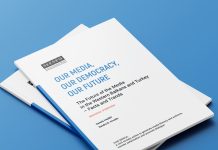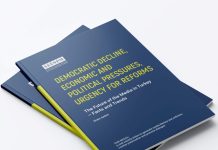When asked whether we should even be on social media, Victoire Rio responds by asking in return: “We must stay, because this is a battlefield. If we leave, who will remain on it?”
By: Feđa Kulenović
“They are not interested in building communities or informing people. They are interested in placing ads,” said Victoire Rio frankly, the founder and director of the aptly named organization “What to Fix” and an expert on information integrity.
And indeed, from the very opening remarks, it was clear that this time we wouldn’t be following the usual pragmatic routes of panels on journalism and social media: how to promote your content more successfully on TikTok or Instagram, what video length performs best, how to capture the audience’s attention with the very first word of a Facebook post, and so on.
At the center of the discussion, which was recently held at the Faculty of Political Sciences in Sarajevo as part of the Our Media conference organized by SEENPM and Mediacentar, lay a much more fundamental question: should we even be on social media at all?
“In journalism, activism, and the fight for human rights, we often rely on social media to reach our audience or to amplify marginalized voices,” explained Marina Grnja from the Novi Sad School of Journalism. “At the same time, these platforms are built on a business model that profits from our attention, our data, and sometimes—even from the spread of disinformation.”
In other words, are we actually feeding the beast that is eating us?
A dilemma that is anything but simple
For Feđa Kulenović, an expert in data and digital security, the mentioned dilemma is anything but simple. On the one hand, as Kulenović vividly put it, saying that we should not be on social media would be like saying that, as journalists or activists trying to protect the weak, the vulnerable, and the marginalized, we should avoid neighborhoods with high crime rates—where they are, in fact, most often the victims.
Still, not every form of presence on social media is a good idea in itself. “We need to build our approach to social media strategically. If we don’t, we simply surrender to the flood and fuel the fire of disinformation,” says Kulenović, acknowledging that for underfunded independent media in the Southeast European region, a carefully thought-out strategic approach to using social networks is not always an option.
Finally, Kulenović believes it is important to recognize that the role of the media has changed. “We are no longer gatekeepers,” he says, pointing out that those in power can now, independently of the media and through social networks, reach their audiences directly, shape their views, and influence their behavior, even through the use of disinformation. Still, that does not mean the media no longer have a role to play.
“There’s a term in telemedicine — apomediation. In a situation where everyone can find medical information online, the role of the doctor has changed — they are no longer the only ones in possession of information, and never will be again. Still, their role is to stand beside the patient and help them discern which sources are accurate and which are not. The same applies to journalists and the media.”
Only the stale crumbs of advertising are left for the media
It’s not a particularly new argument that the difficult economic position of independent media is primarily caused by the disappearance of their former business model, in which their revenues came from advertising. With the emergence of platforms that enabled previously unseen precision in audience targeting, this cake moved to the table of the tech giants, leaving the media with only stale crumbs. For example, Meta, Google, and Amazon alone take more than 50 percent of the global annual advertising budget (and over 60 percent if China is excluded).
However, there is also the view that social media, the fight against disinformation, and the financial sustainability of the media can go hand in hand—at least when it comes to organizations engaged in fact-checking. Since 2016, Meta has invested more than 100 million dollars in supporting fact-checking initiatives. After the program was shut down in the United States in January, this support still represents a significant, though increasingly uncertain, source of income for many organizations in Europe. But does this support make up for the harm done to the media and the public by the mass distribution of disinformation through Meta’s platforms?
“For the past six years, we have been documenting Meta’s monetization program—that is, we compiled a list of all Facebook and Instagram accounts to which Meta pays money for the content they publish. It becomes quite interesting when you start to notice that many of the actors who are the subject of fact-checkers’ work are at the same time earning money from Meta by posting content on Facebook and Instagram. So, you have a company that pays fact-checkers to spend time dealing with the very content whose production Meta itself financially incentivizes,” says Victoire Rio.
“The platforms actually profit from a multitude of actors who produce content in complete violation of their own content policies. They make money from entities that are under some form of sanction on the network, from politicians, political parties, children, the police, and the military—in other words, they do everything their own policies say they shouldn’t do, and in some cases, they may even be breaking the law.”
There aren’t enough journalists who understand this field
Still, part of the problem is on us as well: Kulenović believes that there aren’t enough journalists who understand this field.
“I think the media need to move away from reporting on who tweeted what and start explaining the consequences of all this—and once again become educators. At one time, the job of the media was not only to convey information but also to educate the audience. But before that, we need to educate ourselves.”
About what exactly?
“For independent media and journalists, it is important to have awareness—a strategic awareness—of the ethical use of social media. This means building resilience, that is, ensuring that everyone in the newsroom and the organization is aware of and recognizes the limitations and the harm caused by these platforms, and that they develop practices that allow them to mitigate or avoid those negative effects,” says Rima Sghaier, a researcher and internet freedom activist from Italy.
Is the choice really that easy?
And indeed, there is so much that these practices could entail: exploring alternative platforms and spaces for connecting with audiences (“Newsletters have overwhelmed everyone,” interjects Victoire Rio, “but there are other ways”); gaining more knowledge about the importance of encryption in digital communication (“When someone says, ‘Break encryption,’ attack,” laughs Kulenović, though he doesn’t seem entirely joking), as well as about user and newsroom data privacy, and so on.
Indeed, it sounds like an easy choice: learning and adopting exciting new platforms, tools, and technologies versus pushing out three fact-checked and carefully edited explainers on your Instagram feed by five o’clock today, just to compete for attention with an AI bot flooding your audience with ten meaningless videos per second.
Still, are the media and journalists, under conditions of near-total financial exhaustion, truly free to choose how to spend their time and other resources?
“In budgeting projects submitted to some donors, we often treat the allocation of funds for promotion on social media as mandatory. It is not stated explicitly that it has to be for those platforms, but it is implied by the requirement to have strong communication activities. And it is difficult for us to understand that, in such a poor media market, we have actually set aside a large amount of money for promotion on these platforms,” says Maida Muminović, Executive Director of the Sarajevo-based Mediacentar.
Many in the room nod in agreement, and Maida has a suggestion: “We should advocate that these practices are simply no longer acceptable for many civil society organizations, especially those whose work is rooted in human rights.”
“It really is time—and has been for quite a while—for donors and other decision-makers to start investing money in enabling organizations and media outlets to establish their own independent and decentralized channels, instead of funding the promotion of content on platforms that exploit us,” adds Rima Sghaier.
In conclusion—let’s return to the question from the beginning: to stay or to leave social media?
Victoire Rio has no doubt: “We must stay on that platform, because it is a battlefield. If we leave, who will remain on it?”

The regional program “Our Media: A civil society action to generate media literacy and activism, counter polarisation and promote dialogue” is implemented with the financial support of the European Union by partner organizations SEENPM, Albanian Media Institute, Mediacentar Sarajevo, Press Council of Kosovo, Montenegrin Media Institute, Macedonian Institute for Media, Novi Sad School of Journalism, Peace Institute and Bianet.
This article was produced with the financial support of the European Union. Its contents are the sole responsibility SEENPM and do not necessarily reflect the views of the European Union.
Co-funded by:










